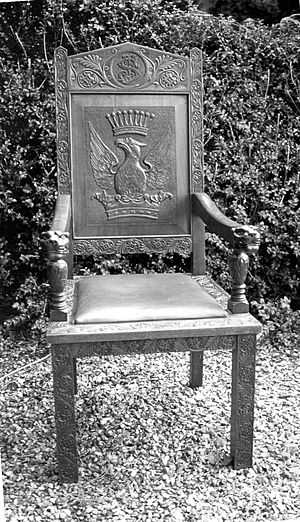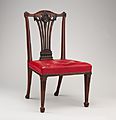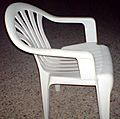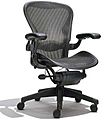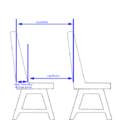Chair facts for kids
A chair is a piece of furniture for sitting, consisting of a seat, a back, and sometimes arm rests, commonly for use by one person. Chairs also often have four legs to support the seat raised above the floor. Even if these legs are cut off, it's still a chair. Without back and arm rests it is called a stool. A chair for more than one person is a couch, sofa, settee, loveseat, recliner or bench. A separate footrest for a chair is known as an ottoman, hassock or pouffe. A chair mounted in a vehicle or in a theater is simply called a seat. Chairs as furniture typically can be moved.
The back often does not extend all the way to the seat to allow for ventilation. Likewise, the back and sometimes the seat are made of porous materials or have holes drilled in them for decoration and ventilation.
The back may extend above the height of the head. There may be separate headrests. Headrests for seats in vehicles are important for preventing whiplash injuries to the neck when the vehicle is involved in a rear-end collision.
Design and ergonomics
Chair design considers intended usage, ergonomics (how comfortable it is for the occupant), as well as non-ergonomic functional requirements such as size, stack ability, fold ability, weight, durability, stain resistance and artistic design. Intended usage determines the desired seating position. "Task chairs", or any chair intended for people to work at a desk or table, including dining chairs, can only recline very slightly; otherwise the occupant is too far away from the desk or table. Dental chairs are necessarily reclined. Easy chairs for watching television or movies are somewhere in between depending on the height of the screen.
Ergonomic designs distributes the weight of the occupant to various parts of the body. A seat that is higher results in dangling feet and increased pressure on the underside of the knees ("popliteal fold"). It may also result in no weight on the feet which means more weight elsewhere. A lower seat may shift too much weight to the "seat bones" ("ischial tuberosities").
A reclining seat and back will shift weight to the occupant's back. This may be more comfortable for some in reducing weight on the seat area, but may be problematic for others who have bad backs. In general, if the occupant is suppose to sit for a long time, weight needs to be taken off the seat area and thus "easy" chairs intended for long periods of sitting are generally at least slightly reclined. However, reclining may not be suitable for chairs intended for work or eating at table.
The back of the chair will support some of the weight of the occupant, reducing the weight on other parts of the body. In general, backrests come in three heights: Lower back backrests support only the lumbar region. Shoulder height backrests support the entire back and shoulders. Headrests support the head as well and are important in vehicles for preventing "whiplash" neck injuries in rear-end collisions where the head is jerked back suddenly. Reclining chairs typically have at least shoulder height backrests to shift weight to the shoulders instead of just the lower back.
Some chairs have foot rests. A stool or other simple chair may have a simple straight or curved bar near the bottom for the sitter to place his/her feet on.
Images for kids
-
Chair, circa 1772, mahogany, covered in modern red morocco leather, height: 97.2 cm, Metropolitan Museum of Art (New York City)
-
The Coronation Chair, circa 1300
-
The Monobloc chair is a lightweight stackable polypropylene chair, usually white in colour, often described as the world's most common plastic chair.
-
Metal chairs in the Tuileries Garden, Paris, France
-
The type of chair popular in western Hubei, China: with a fairly low seat and the back inclined at about 45 degrees from the vertical
-
Highly decorated carved-back chairs in Mexico
-
Eames Lounge chair and ottoman
See also
 In Spanish: Silla para niños
In Spanish: Silla para niños



